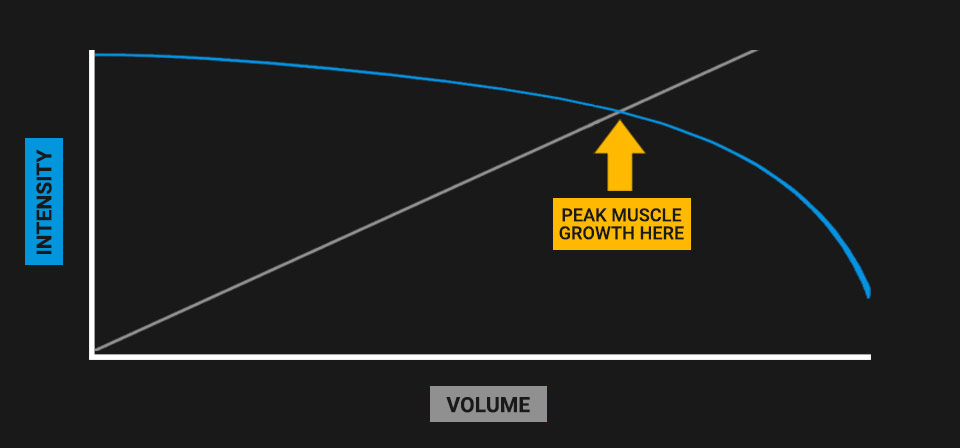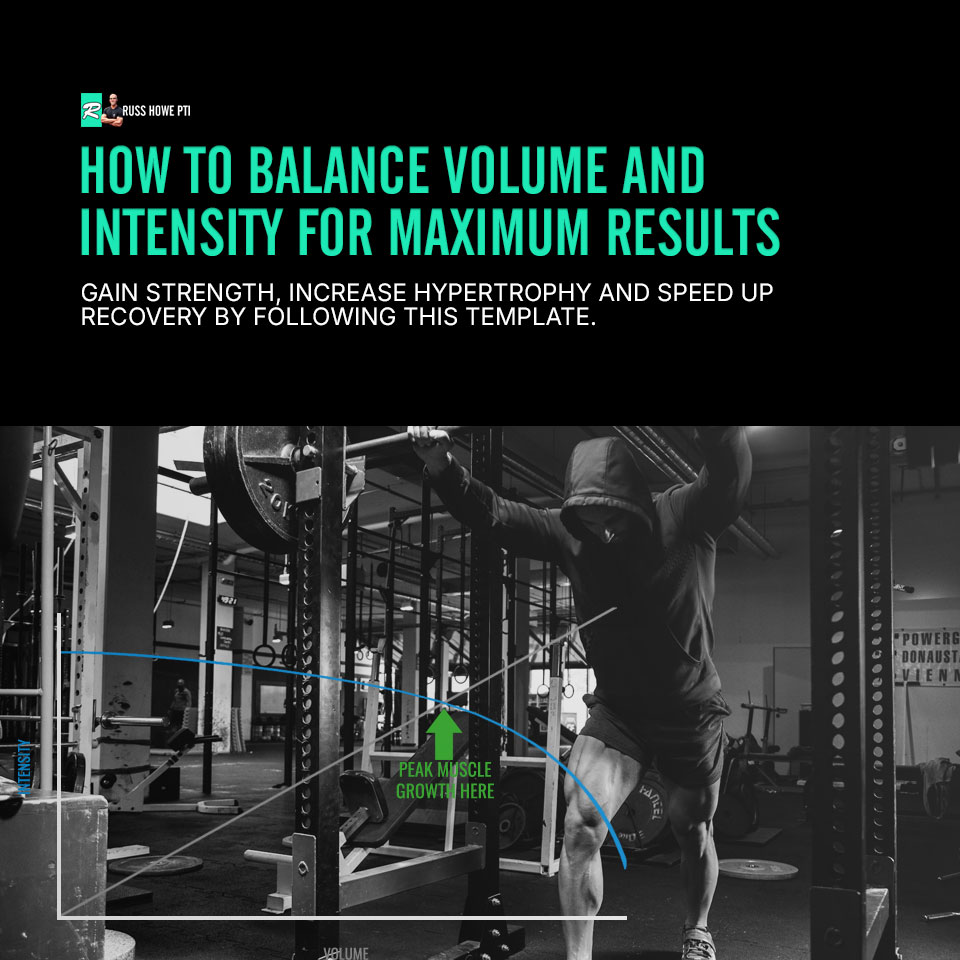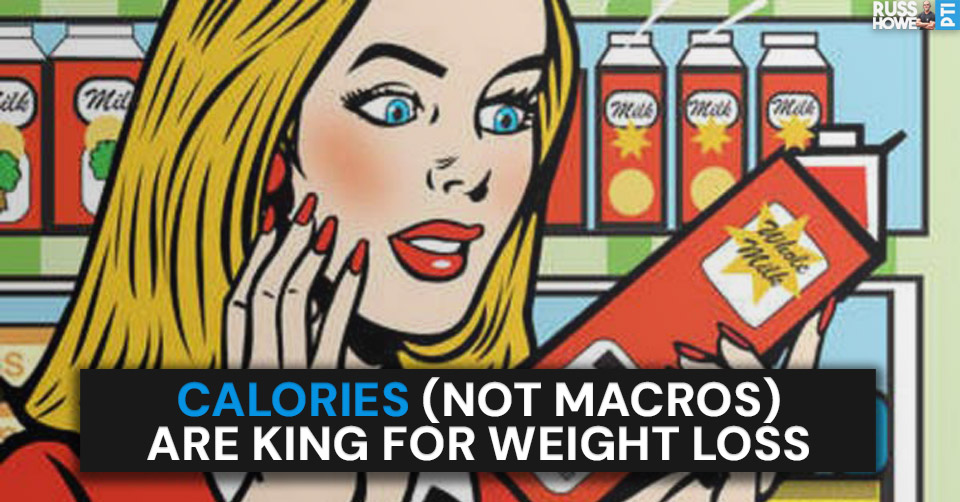Volume and intensity are two crucial components of your overall workout program.
If you’re unfamiliar with the terms, “volume” refers to the number of sets each muscle receives per week (not per workout), and “intensity” describes how challenging those sets are.
So it should make sense that as one goes up, the other goes down, right?
(e.g. if we keep adding more sets, the productivity of those sets is diluted because we are tired.)

If a trainee can learn how to strike the optimal balance between volume and intensity, they are able to make sure that every workout falls into the so-called “sweet spot” for hypertrophy, where performance is maximized, muscle growth is turned up to eleven, and muscle recovery is still sufficient that you can train again the next day.
Now I know you’re asking the all-important question:
Where is this so-called “sweet spot” and how do I hit it?
In asking the question, you’re joining decades of trainees who came before you, from newbie lifters to seasoned veterans alike (newbie lifters always want to know how many sets are necessary to achieve the fastest results, meanwhile experienced lifters usually want to know how long they can annihilate a muscle before “high volume” becomes “junk volume”).
Sadly, we never really had a solid base of research to give the answers, so many people just fucked around and found out.
But guess what?
WE DO NOW!

In General, More Volume = More Results
The easiest way to get better at something is to do it a lot.
This statement is not just true in everyday life, but also with regards to building muscle.
A study published in the Journal of Strength and Conditioning Research seems to confirm the belief that “more volume = better results”. The researchers had 3 groups of trainees using one of the following 12-week programs:
- Group A: 1 set per exercise
3 workouts per week with just 1 set per exercise, so each muscle got 3 sets over the course of a week. - Group B: 3 sets per exercise
3 workouts per week with 3 sets per exercise, so each muscle got 9 sets over the course of a week. - Group C: 5 sets per exercise
3 workouts per week with 5 sets per exercise, so each muscle got 15 sets over the course of a week.
The exercises used were leg press, leg extension, leg curl, bench press, shoulder press, wide-grip lat pulldown, biceps curl, triceps extension, and crunches.
The results were pretty interesting:
As you can see in my lovely graph, the trainees who did the highest amount of volume (Group C) achieved more muscle growth, better strength gains, and a bigger increase to their endurance.
This shows us that as a general rule more volume will give you better results. (1, 2)

Is There A Point Of Diminishing Returns?
Yes, there’s a tipping point.
The study above achieved the best results when trainees hit each muscle with 15 sets per week, but if we were to continue adding more volume on top of this (e.g. 18, 21, or even 50 sets per week) we would eventually reach a point where results stagnated.
Some people refer to this phenomenon as overtraining, but I’ve always preferred calling it under-recovering, because this alludes to the real root cause of the problem…
Advice For Newbie Lifters (-2 Years)
If you’ve been lifting for less than two years you’ll want to hit each muscle with 12-18 sets per week.
That’s where most of the research on this topic unlocked the best results. (2, 3, 4, 5, 7, 10)
Don’t worry if your experienced gym buddy says this isn’t enough volume, because science shows that it absolutely is. As a newbie lifter you’ll benefit far more from longer recovery time than your experienced friend. To demonstrate this point, a 2017 study from Australia discovered that newbie lifters actually recorded better muscle building and strength gains when they halved their workout volume from 10 sets per exercise to 5 sets per exercise. (6)
Similarly, in 2019 researchers from the USA found that newbie lifters achieved greater biceps growth when reducing the volume in their arm workouts from 27 sets to 18 sets. Also, a study from Wales showed that newbie lifters achieved greater triceps growth when halving their volume from 28 sets to 14 sets. (8, 9)

“If you have less than 2 years of lifting experience you should aim for 12-18 sets per week for each muscle group. You can do this in one workout (e.g. a bro split) or spread the load across multiple sessions (e.g. a full-body split). (11, 15, 16)
Also, if you take around half of your sets to the point of muscle failure you’ll see even better results!”
– Russ Howe PTI
If you are a beginner lifter (-2 years training experience) consider starting with one of the following russhowepti.com training programs and see what your results look like:
Advice For Experienced Lifters (2+ Years)
Those of you with 2+ years of experience can subject your body to a greater degree of punishment.
Aim for 18-30 sets per week.
One of the adaptations the body makes to long-term training is to become more efficient at recovering, so your superior conditioning enables you to pile a little bit more volume in each week. (11, 12, 13, 14)

“If you have more than 2 years of lifting experience you should aim for 18-30 sets per week for each muscle group. This can be achieved all in one workout (e.g. a bro split) or by spreading the load over multiple sessions (e.g. a full-body split).
Your muscles have a greater level of conditioning so you’ll have to work harder to achieve true muscle failure. Therefore you can utilize intensity-boosting techniques such as dropsets, supersets, and rest pause sets as a way to sneak in more volume without doing traditional sets if you wish.”
– Russ Howe PTI
If you are an advanced lifter (2+ years training experience), try doing one of the following russhowepti.com training programs:

Further Reading:
If you enjoyed this blog, then you’ll probably also like reading these.
>> High Reps vs Low Reps For Muscle Growth
>> How To Use Periodization Like A Pro
>> Stallone Was Right: Circuit Training Rocks!
References:
- Radaelli R., et al. Dose-response of 1, 3, and 5 sets of resistance exercise on strength, local muscular endurance, and hypertrophy. J Strength Cond Res (2015).
- Schoenfeld B. J., et al. Dose-response relationship between weekly resistance training volume and increases in muscle mass: A systematic review and meta-analysis. J Sports Sci (2017).
- Helms E. R., et al. Recommendations for natural bodybuilding contest preparation: resistance and cardiovascular training. J Sports Med Phys Fitness (2015).
- Hammarström D., et al. Benefits of higher resistance-training volume are related to ribosome biogenesis. J Physiol (2020).
- Wernbom M., et al. The influence of frequency, intensity, volume and mode of strength training on whole muscle cross-sectional area in humans. Sports Med (2007).
- Amirthalingam T., et al. Effects of a Modified German Volume Training Program on Muscular Hypertrophy and Strength. J Strength Cond Res (2017).
- Fry A. C., et al. Resistance exercise overtraining and overreaching. Neuroendocrine responses. Sports Med (1997).
- Heaselgrave S. R., et al. Dose-Response Relationship of Weekly Resistance-Training Volume and Frequency on Muscular Adaptations in Trained Men. Int J Sports Physiol Perform (2019).
- Otrowski K. J., et al. The Effect of Weight Training Volume on Hormonal Output and Muscular Size and Function. J Strength Cond Res (1997)
- Peterson M. D., et al. Applications of the dose-response for muscular strength development: a review of meta-analytic efficacy and reliability for designing training prescription. J Strength Cond Res (2005).
- Schoenfeld B. J., et al. Influence of Resistance Training Frequency on Muscular Adaptations in Well-Trained Men. J Strength Cond Res (2015).
- Schoenfeld B. J., et al. Resistance Training Volume Enhances Muscle Hypertrophy but Not Strength in Trained Men. Med Sci Sports Exerc (2019).
- Aube D., et al. Progressive Resistance Training Volume: Effects on Muscle Thickness, Mass, and Strength Adaptations in Resistance-Trained Individuals. J Strength Cond Res (2022).
- Brigatto F. A., et al. High Resistance-Training Volume Enhances Muscle Thickness in Resistance-Trained Men. J Strength Cond Res (2022).
- Keieger J. Set Volume for Muscle Size: The Ultimate Evidence Based Bible. Weightology (2022).
- Raastad T., et al. Powerlifters improved strength and muscular adaptations to a greater extent when equal total training volume was divided into 6 compared to 3 training sessions per week. Book of abstracts, 17th annual conference of the ECSS (2012).















Leave a Reply to Why Full-Body Training Totally Rocks • Russ Howe PTI Cancel reply